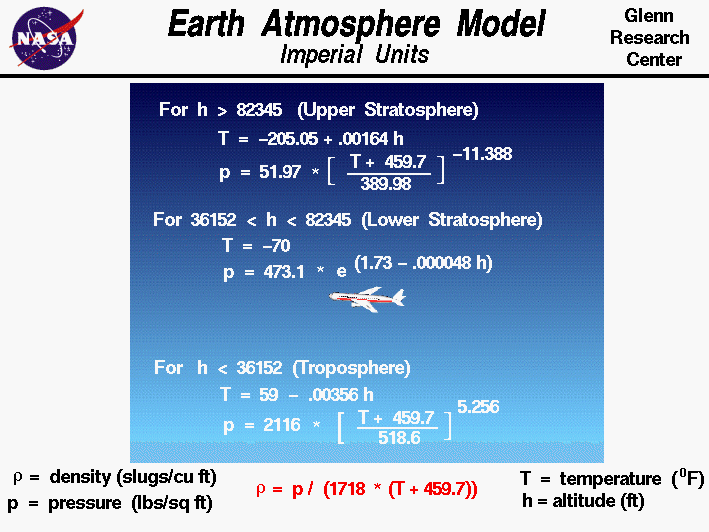
The Earth's
atmosphere
is an extremely thin
sheet of air
extending from the surface of the Earth to the edge of space, about 60 miles
above the surface of the Earth. If the
Earth were the size of a basketball, a tightly held pillowcase would
represent the thickness of the atmosphere.
Gravity
holds the
atmosphere to the Earth's surface. Within the atmosphere, very
complex chemical, thermodynamic, and
fluid dynamics effects occur. The
atmosphere is not uniform; fluid properties are constantly changing
with time and place. We call this change the weather.
Variations in air properties extend upward from the surface of the Earth.
The sun
heats
the surface of the Earth, and some of this heat goes into
warming the air near the surface.
The heated air is then diffused
or convected up through the atmosphere.
Thus the air temperature
is highest near the surface and decreases as altitude increases.
The speed of sound
depends on the temperature and also decreases with increasing altitude.
The pressure of the air can be related to
the weight of the air over a given location. As we increase altitude
through the atmosphere, there is some air below us and some air
above us. But there is always less air above us than was present
at a lower altitude. Therefore, air pressure decreases as we increase
altitude. The air density depends on both
the temperature and the pressure through the equation
of state
and also decreases with increasing altitude.
Aerodynamic forces
directly depend on
the air density. To help aircraft designers, it is useful to define a
standard atmosphere model of the variation of properties
through the atmosphere. There are actually several different
models available--a standard or average day, a hot day, a cold day, and a
tropical day. The models are updated every few years to include
the latest atmospheric data. The model was developed from
atmospheric measurements that were averaged and curve fit to produce
the given equations. The model assumes that the pressure and
temperature change only with altitude. The particular model shown
here was developed in the early sixties, and the curve fits are given
for Imperial units. Curve fits are also available in metric
units.
The model has three zones with separate curve fits
for the troposphere, the lower stratosphere, and the upper stratosphere.
The troposphere runs from the surface of the Earth to 36,152 feet.
In the troposphere, the temperature decreases linearly and the pressure
decreases exponentially. The rate of temperature decrease is called the
lapse rate. For the temperature T and the pressure p,
the Imperial units curve fits for the troposphere are:
T = 59 - .00356 * h
p = 2116 * [(T + 459.7)/ 518.6]^5.256
where the temperature is given in Fahrenheit degrees, the pressure in pounds/square feet,
and h is the altitude in feet.
The lower stratosphere runs from 36,152 feet to 82,345 feet.
In the lower stratosphere the temperature is constant and the pressure
decreases
exponentially.
The Imperial units curve fits for the lower stratosphere are:
T = -70
p = 473.1 * exp(1.73 - .000048 * h)
The upper stratosphere model is used for altitudes above 82,345 feet.
In the upper stratosphere the temperature increases slightly and the pressure
decreases exponentially.
The Imperial units curve fits for the upper stratosphere are:
T = -205.05 + .00164 * h
p = 51.97 * [(T + 459.7)/ 389.98]^-11.388
In each zone the
density r is derived from the
equation of state.
r = p / [1718 * (T + 459.7)]
This is the atmosphere model used
in the FoilSim
and
EngineSim
computer simulators. An
interactive simulation
for the atmosphere model is also available. With the
applet, you can change altitude and see the effects on pressure and
temperature.
Activities:









Guided Tours
-
 Interactive Atmosphere Model:
Interactive Atmosphere Model:

Navigation ..




- Beginner's Guide Home Page
|
